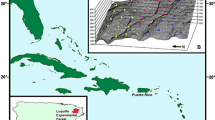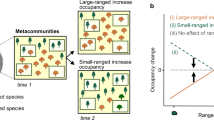Abstract
Techniques to evaluate elements of metacommunity structure (EMS; coherence, species turnover and range boundary clumping) have been available for several years. Such approaches are capable of determining which idealized pattern of species distribution best describes distributions in a metacommunity. Nonetheless, this approach rarely is employed and such aspects of metacommunity structure remain poorly understood. We expanded an extant method to better investigate metacommunity structure for systems that respond to multiple environmental gradients. We used data obtained from 26 sites throughout Paraguay as a model system to demonstrate application of this methodology. Using presence–absence data for bats, we evaluated coherence, species turnover and boundary clumping to distinguish among six idealized patterns of species distribution. Analyses were conducted for all bats as well as for each of three feeding ensembles (aerial insectivores, frugivores and molossid insectivores). For each group of bats, analyses were conducted separately for primary and secondary axes of ordination as defined by reciprocal averaging. The Paraguayan bat metacommunity evinced Clementsian distributions for primary and secondary ordination axes. Patterns of species distribution for aerial insectivores were dependent on ordination axis, showing Gleasonian distributions when ordinated according to the primary axis and Clementsian distributions when ordinated according to the secondary axis. Distribution patterns for frugivores and molossid insectivores were best described as random. Analysis of metacommunities using multiple ordination axes can provide a more complete picture of environmental variables that mold patterns of species distribution. Moreover, analysis of EMS along defined gradients (e.g., latitude, elevation and depth) or based on alternative ordination techniques may complement insights based on reciprocal averaging because the fundamental questions addressed in analyses are contingent on the ordination technique that is employed.




Similar content being viewed by others
References
Anderson S (1997) Mammals of Bolivia, taxonomy and distribution. Bull Am Mus Nat Hist 231:1–652
Bloch CP, Higgins CL, Willig MR (2007) Effects of large-scale disturbance on community structure: temporal trends in nestedness. Oikos 116:395–406
Burns KC (2007) Network properties of an epiphyte metacommunity. J Ecol 95:1142–1151
Chalcraft DR, Williams JW, Smith MD, Willig MR (2004) Scale dependence in the species-richness-productivity relationship: the role of species turnover. Ecology 85:2701–2708
Clements FE (1916) Plant succession: an analysis of the development of vegetation. Carnegie Institution of Washington, Washington, DC
Comisión Nacional de Desarrollo Regional Integrado del Chaco (1986) Memoria del Mapa Hidrogeológico de la Republica del Paraguay. Gobierno de la Republica del Paraguay, Asunción
Dolan PG (1989) Systematics of middle American mastiff bats of the genus Molossus. Special publications. The Museum, Texas Tech University, Lubbock
Fariña Sánchez T (1973) The climate of Paraguay. In: Gorham JR (ed) Paraguay: ecological essays. Academy of Arts and Sciences of the Americas, Miami, pp 33–38
Fauth JE, Bernardo J, Camara M, Resetarits WJ, Van Buskirk J, McCollum SA (1996) Simplifying the jargon of community ecology: a conceptual approach. Am Nat 147:282–286
Gauch HG (1982) Multivariate analysis in community ecology. Cambridge University Press, Cambridge
Gauch HG, Whittaker RH, Wentworth TR (1977) A comparative study of reciprocal averaging and other ordination techniques. J Ecol 65:157–174
Gotelli NJ (2000) Null model analysis of species co-occurrence patterns. Ecology 81:2606–2621
Gotelli NJ, Graves GR (1996) Null models in ecology. Smithsonian Institution Press, Washington, DC
Hausdorf B, Hennig C (2007) Null model tests of clustering of species, negative co-occurrence patterns and nestedness in meta-communities. Oikos 116:818–828
Hayes FE (1995) Status, distribution, and biogeography of the birds of Paraguay. Monogr Field Ornithol 1:1–230
Heino J (2005) Metacommunity patterns of highly diverse stream midges: gradients, chequerboards, and nestedness, or is there only randomness? Ecol Entomol 30:590–599
Hoagland BW, Collins SL (1997) Gradient models, gradient analysis, and hierarchical structure in plant communities. Oikos 78:23–30
Hofer U, Bersier LF, Borcard D (1999) Spatial organization of a herpetofauna on an elevational gradient revealed by null model tests. Ecology 80:976–988
Holyoak M, Holt RD, Leibold MA (eds) (2005) Metacommunities: spatial dynamics and ecological communities. University of Chicago Press, Chicago
Huang C, Kim S, Altstatt A, Townshend JRG, Davis P, Song K, Tucker CJ, Rodas O, Yanosky A, Clay R, Musinsky J (2007) Rapid loss of Paraguay’s Atlantic forest and the status of protected areas—a landsat assessment. Remote Sens Environ 106:460–466
Hylander K, Nilsson C, Jonsson BG, Göthner T (2005) Differences in habitat quality explain nestedness in a land snail meta-community. Oikos 108:351–361
Jonsson BG (2001) A null model for randomization tests of nestedness in species assemblages. Oecologia 127:309–313
Keel S, Gentry AH, Spinzi L (1993) Using vegetation analysis to facilitate the selection of conservation sites in eastern Paraguay. Conserv Biol 7:66–75
Kusch J, Goedert C, Meyer M (2005) Effects of patch type and food specializations on fine spatial scale community patterns of nocturnal forest associated Lepidoptera. J Res Lepidop 38:67–77
Leibold MA, Mikkelson GM (2002) Coherence, species turnover, and boundary clumping: elements of meta-community structure. Oikos 97:237–250
Leibold MA, Miller TE (2004) From metapopulations to metacommunities. In: Hanski IA, Gaggiotti OE (eds) Ecology, genetics and evolution of metacommunities. Elsevier, Burlington, pp 133–150
Leibold MA, Chase JM, Shurin JB, Downing AL (1997) Species turnover and the regulation of trophic structure. Annu Rev Ecol Syst 28:467–494
Leibold MA, Holyoak M, Mouquet M, Amarasekare P, Chase JM, Hoopes MF, Holt RD, Shurin JB, Law R, Tilman D, Loreau M, Gonzalez A (2004) The metacommunity concept: a framework for multi-scale community ecology. Ecol Lett 7:601–613
López-González C (1998) Systematics and zoogeography of the bats of Paraguay. Unpublished Ph.D. dissertation, Texas Tech University, Lubbock
López-González C (2004) Ecological zoogeography of the bats of Paraguay. J Biogeogr 31:33–45
López-González C (2005) Murciélagos del Paraguay. Comité Español MAB y Red Ibero MAB, México DF
Mares MA, Willig MR, Streilein KE, Lacher TE (1981) The mammals of northeastern Brazil: a preliminary assessment. Ann Carnegie Mus 50:81–137
Morisita M (1971) Composition of the I-index. Res Popul Ecol 13:1–27
Myers P (1982) Origins and affinities of the mammal fauna of Paraguay. In: Mares MA, Genoways HH (eds) Mammalian biology in south America. Special publications series, Pymatuning Laboratory of Ecology. University of Pittsburgh, Pittsburgh, pp 85–93
Norberg UM, Rayner JMV (1987) Ecological morphology and flight in bats (Mammalia; Chiroptera): wing adaptations, flight performance, foraging strategy and echolocation. Philos Trans Roy Soc B 316:335–427
Peet RK (1974) The measurement of species diversity. Annu Rev Ecol Syst 5:285–307
Pielou EC (1984) The interpretation of ecological data: a primer on classification and ordination. Wiley, Hoboken
Redford KH, Eisenberg JF (1992) Mammals of the Neotropics: the southern Cone, Chile, Argentina, Uruguay, Paraguay, vol 2. University of Chicago Press, Chicago
Ríos E, Zardini E (1989) Conservation of biological diversity in Paraguay. Conserv Biol 3:118–120
Simmons NB (2005) Order Chiroptera. In: Wilson DE, Reeder DM (eds) Mammal species of the world: a taxonomic and geographic reference, vol 1, 3rd edn. Johns Hopkins University Press, Baltimore, pp 312–529
Stevens RD (2004) Untangling latitudinal richness gradients at higher taxonomic levels: familial perspectives on the diversity of New World bat communities. J Biogeogr 31:665–674
Stevens RD, Cox SB, Strauss RE, Willig MR (2003) Patterns of functional diversity across an extensive environmental gradient: vertebrate consumers, hidden treatments and latitudinal trends. Ecol Lett 6:1099–1108
Stevens RD, Willig MR, Gamarra de Fox I (2004) Comparative community ecology of bats in eastern Paraguay: taxonomic, ecological, and biogeographic perspectives. J Mammal 85:698–707
Stevens RD, López-González C, Presley SJ (2007) Geographical ecology of Paraguayan bats: spatial integration and metacommunity structure of interacting assemblages. J Anim Ecol 76:1086–1093
R Development Core Team (2005) R: a language and environment for statistical computing. R Foundation for Statistical Computing, Vienna. ISBN 3-900051-07-0, URL http://www.R-project.org
Veech JA, Summerville KS, Crist TO, Gering JC (2002) The additive partitioning of species diversity: recent revival of an old idea. Oikos 99:3–9
Werner EE, Skelly DK, Relyea RA, Yurewicz KL (2007) Amphibian species richness across environmental gradients. Oikos 116:1697–1712
Willig MR, Presley SJ, Owen RD, López-González C (2000) Composition and structure of bat assemblages in Paraguay: a subtropical-temperate interface. J Mammal 81:386–401
Wilson DE (1973) Bat faunas: a trophic comparison. Syst Zool 22:14–29
Wright DH, Reeves JH (1992) On the meaning and measurement of nestedness of species assemblages. Oecologia 92:416–428
Wright DH, Patterson BD, Mikkelson GM, Cutler A, Atmar W (1998) A comparative analysis of nested subset patterns of species composition. Oecologia 113:1–20
Zimmerman MS (2006) Predator communities associated with brook stickleback (Culaea inconstans) prey: patterns in body size. Can J Fish Aquat Sci 63:297–309
Acknowledgements
S. J. P. was supported by the Center for Environmental Sciences and Engineering at the University of Connecticut during preparation of this manuscript. An exclusivity grant from COFAA-IPN and project SIP (2008-0193) supported C. L. G. during the development of this manuscript. Data collection was supported by the National Science Foundation via grants DEB-9400926, DEB-9741543 and DEB-9741134 to R. Owen and M. Willig, and by a Grant-in-aid from the American Society of Mammalogists to C. L. G. We thank curators and collection managers at The Museum of Texas Tech University, Museum d’Histoire Naturelle, Geneva, Switzerland, Museo Nacional de Historia Natural del Paraguay, U.S. National Museum of Natural History, Estación Biológica de Doñana, University of Connecticut, Museum of Zoology, University of Michigan, Museum of Vertebrate Zoology, Field Museum of Natural History, Museum of Comparative Zoology and American Museum of Natural History for granting access to their collections. Matlab script files were written by R. Strauss and C. Higgins. All research complied with the current laws of Paraguay. The exposition of the manuscript was improved as a consequence of comments provided by M. Leibold and an anonymous reviewer.
Author information
Authors and Affiliations
Corresponding author
Additional information
Communicated by Elisabeth Kalko.
Rights and permissions
About this article
Cite this article
Presley, S.J., Higgins, C.L., López-González, C. et al. Elements of metacommunity structure of Paraguayan bats: multiple gradients require analysis of multiple ordination axes. Oecologia 160, 781–793 (2009). https://doi.org/10.1007/s00442-009-1341-x
Received:
Accepted:
Published:
Issue Date:
DOI: https://doi.org/10.1007/s00442-009-1341-x




